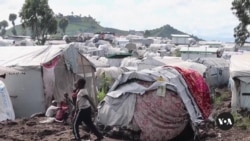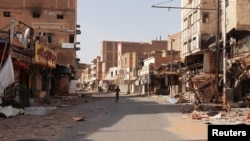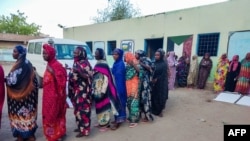Conflicts and violence have pushed the number of internally displaced people around the world to a record-breaking high of 75.9 million, with nearly half living in sub-Saharan Africa, according to a new report by the Internal Displacement Monitoring Center.
The report finds conflicts in Sudan, the Democratic Republic of Congo and Palestinian territories accounted for nearly two-thirds of new displacements due to violence, which in total spanned 66 countries in 2023.
“Over the past two years, we have seen alarming new levels of people having to flee their homes due to conflict and violence, even in regions where the trend had been improving,” Alexandra Bilak, IDMC director said.
In a statement to coincide with the publication of the report Tuesday, she said that the millions of people forced to flee in 2023 were just “the tip of the iceberg.”
“Conflict, and the devastation it leaves behind, is keeping millions from rebuilding their lives, often for years on end,” she said.
WATCH: Wars in Sudan, Gaza, DRC drive internally displaced to record 76 million
The report notes the number of internal displacements, that is the number of times people have been forced to move throughout the year to escape conflict within their country, has increased in the last couple of years.
“While we hear a lot about refugees or asylum-seekers who cross the border, the majority of the displaced people actually stay within their country and they are internally displaced,” Christelle Cazabat, head of programs at IDMC, told journalists in Geneva Monday, in advance of the launch of the report.
In its 2023 report on forcibly displaced populations, the U.N. refugee agency, UNHCR, reported that 62.5 million people had been internally displaced people at the end of 2022 compared to 36.4 million refugees who had fled conflict, violence and persecution that same year.
According to the IDMC, new internal displacements last year were mostly due to the conflict in Ukraine, which started in 2022, as well as to the ongoing conflict in the Democratic Republic of the Congo and the eruption of war in mid-April 2023 in Sudan.
The war in Sudan resulted in 6 million internal displacements last year, which was “more than its previous 14 years combined” and the second most ever recorded in one country during a single year after Ukraine’s 16.9 million in 2022, according to the report.
“As you know, it is more than a year that this new wave of conflict erupted (in Sudan) and as of the end of last year, the figure was 9.1 million” displaced in total by the conflict, said Vicente Anzellini, IDMCs global and regional analysis manager and lead author of the report.
“This figure is the highest that we have ever reported for any country, this 9.1 million internally displaced people.”
In the Gaza Strip, IDMC calculated 3.4 million displacements in the last three months of 2023, many of whom had been displaced multiple times during this period. It says this number represented 17% of total conflict displacements worldwide during the year, noting that a total of 1.7 million Palestinians were internally displaced in Gaza by the end of the year.
The last quarter of 2023 is the period following the Hamas terrorists’ brutal attack on Israel on Oct. 7, eliciting a military response from Israel on the Palestinian enclave.
“There are many other crises that are actually displacing even more people, but we hear a little bit less of them,” said Cazabat, noting that little is heard about the “acute humanitarian crisis in Sudan” though it has the highest number of people “living in internal displacement because of the conflict at the end of last year.”
In the past five years, the report finds the number of people living in internal displacement because of conflict and violence has increased by 22.6 million.
Sudan topped last year’s list of 66 countries with 9.1 million people displaced internally because of conflict, followed by Syria with more than 7 million, the DRC, Colombia and Yemen.
Besides the total of 68.3 million people who were displaced globally by conflict and violence in 2023, the report says 7.7 million were displaced by natural disasters, including floods, storms, earthquakes and wildfires.
As in previous years, the report notes that floods and storms caused the most disaster displacement, including in southeastern Africa, where cyclone Freddy triggered 1.4 million movements across six countries and territories.
The earthquakes that struck Turkey and Syria triggered 4.7 million displacements, one of the largest disaster displacement events since records began in 2008.
Anzellini observed many countries that have experienced conflict displacement also have experienced disaster displacement.
“In many situations, they are overlapping. This is the case in Sudan, in South Sudan, but also in Somalia, in the DRC, and other places,” he said. “So, you can imagine fleeing from violence to save your life and then having to escape to higher ground with whatever you can carry as the storm or a flood threatens to wash away your temporary shelter.”
He said that no country is immune to disaster displacement.
“Last year, we recorded disaster displacements in 148 countries and territories, and these include high-income countries such as Canada and New Zealand, which recorded their highest figures ever.
“Climate change is making extreme weather events more frequent and more intense and that can lead to more displacement, but it does not have to,” he said, noting that climate change is one of many factors that contribute to displacement.
“There are other economic, social and political factors that governments can address to actually minimize the impacts of displacement even in the face of climate change,” he said, including early warning systems and the evacuation of populations before a natural disaster is forecast to strike.















